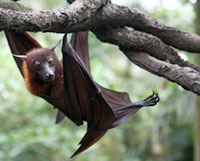
News |
- Ontario Mandates 'Drying For Freedom'
- Haida Nation and Canada to Manage Marine Area
- Court Upholds Need for Environmental Assessment
- FDA Looks Again at Bisphenol A
- Precaution Vs. Pollution: LP Anniversary
- Polar Bears Shifting Habitat Use
- Pesticide Use Linked to Die-Offs
- First Nations Leaders Sign Climate Declaration
- Clean Electricity for British Columbia
- 2010 International Year of Biodiversity
- Pesticide Removed from Market to Save Bees
- Quebec's GHG Reduction Goals
| Ontario Mandates 'Drying For Freedom' | 30 January 10 |
 Ontario residents can now hang their clothes and linens outside to dry after the Premier lifted the ban on outdoor clotheslines. Previously there were restrictions in many Ontario subdivisions because clotheslines were considered unsightly. The province's new regulation will overrule neighbourhood or lease rules. Ontario residents can now hang their clothes and linens outside to dry after the Premier lifted the ban on outdoor clotheslines. Previously there were restrictions in many Ontario subdivisions because clotheslines were considered unsightly. The province's new regulation will overrule neighbourhood or lease rules.Premier Dalton McGuinty said the move is aimed at curbing use of energy-sucking dryers, which burn up to six per cent of Ontario's power. This recent change is one of many in a movement pushing for less restrictions in the use of clothes lines. A new documentary, Drying For Freedom, highlights the banning of clothes lines in over 50 million homes in the United States, translating 5 billion dollars a year in electricity bills. The documentary follows the battle for the right to dry clothes asking why drying clothes became an environmental and social catastrophe and questions clotheslines being banned. View April 18, 2008 CTV News articleVisit Let's Hang Out Canada website Visit Drying For Freedom website View January 2010 The Sierra Club News Letter Source: The Sierra Club, CTV.ca |
|
 Print version Print version |
Top |
| Haida Nation and Canada to Manage Marine Area | 28 January 10 |
 The Council of the Haida Nation, Parks Canada, and Fisheries and Oceans Canada have signed a long-awaited agreement to cooperatively manage proposed Gwaii Haanas national marine conservation area. The Council of the Haida Nation, Parks Canada, and Fisheries and Oceans Canada have signed a long-awaited agreement to cooperatively manage proposed Gwaii Haanas national marine conservation area.Located at the southern part of Haida Gwaii, Gwaii Haanas is widely considered an environmental jewel. The federal government and the Haida previously protected the land through a national park reserve and Haida Heritage Site. But the surrounding ocean ecosystem remains largely unprotected, despite a commitment to also protect it, made over 20 years ago. The partnership agreement is an important step forward for a future Gwaii Haanas National Marine Conservation Area (NMCA). A similar partnership for the management of the Gwaii Haanas national park reserve is an international model for cooperative management. View January 20, 2010 CPAWS articleView January 16, 2010 WWF article View January 16, 2010 Parks Canada press release View January 16, 2010 Earth Times article View January 16, 2010 Market Wire article Sources: CPAWS, Parks Canada, WWF EarthTimes |
|
 Print version Print version |
Top |
| Court Upholds Need for Environmental Assessment | 28 January 10 |
 The Supreme Court of Canada has ruled the Canadian government violated Canada's environmental law. In a case centered on the proposed British Columbia Red Chris, the Court ruled the federal government cannot split projects into artificially small parts to avoid rigorous environmental assessment. The ruling also guarantees the public will be consulted about major industrial projects, including large metal mines and tar sands developments. The Supreme Court of Canada has ruled the Canadian government violated Canada's environmental law. In a case centered on the proposed British Columbia Red Chris, the Court ruled the federal government cannot split projects into artificially small parts to avoid rigorous environmental assessment. The ruling also guarantees the public will be consulted about major industrial projects, including large metal mines and tar sands developments."The Supreme Court has given Canadians back their voice and, with it, their ability to influence major industrial development across the country," said Ecojustice lawyer Lara Tessaro, who represented MiningWatch Canada. "This landmark decision confirms that the government can no longer shirk the environmental protection duties that Parliament has assigned to it." The proposed open-pit mine would be located adjacent to an area called the Sacred Headwaters, the birthplace of the Stikine, Nass and Skeena Rivers. If built, it would endanger wildlife, destroy three trout-bearing streams and risk toxic contamination of two watersheds. The proposed mining project would wipe out pristine Black Lake by converting it into a "tailings impoundment area" - a dumpsite for toxic mine waste. "These are serious issues where the public needs to be able to have a say. That's what we thought the law said, and now the Court has backed us up," said Jamie Kneen of MiningWatch Canada. View January 21, 2010 Supreme Court of Canada JudgementView January 21, 2010 Nation Talk article View January 21, 2010 CBC News article View January 21, 2010 MiningWatch Canada press release View EcoJustice case study View December 20, 2009 Indigenous Peoples Issues and Resources article Source: Nationtalk.ca |
|
 Print version Print version |
Top |
| FDA Looks Again at Bisphenol A | 22 January 10 |
 US Food and Drug Administration officials pledged to study Bisphenol A (BPA) more closely. The US Department of Health and Human Services issued recommendations the same day that consumers throw away scratched cups and bottles with BPA because small amounts of the chemical can seep out. US Food and Drug Administration officials pledged to study Bisphenol A (BPA) more closely. The US Department of Health and Human Services issued recommendations the same day that consumers throw away scratched cups and bottles with BPA because small amounts of the chemical can seep out."Recent reports show subtle effects of BPA in lab animals that has raised concerns," said William Corr, deputy secretary of Health and Human Services. His agency will spend $30 million to study the chemical's effect on young children. "We are taking a much closer look." The FDA had long declared BPA safe for adults and children. Now, according to FDA Commissioner Margaret Hamburg, BPA is of "some concern" for infants and children. Many manufacturers have voluntarily replaced BPA in products ranging from baby bottles to drinking water containers and some stores such as Wal-Mart have agreed to discontinue carrying some items. As of June 2009, Canada's federal government proposed regulations to prohibit the advertisement, sale and importation of polycarbonate plastic baby bottles that contain BPA. View January 15, 2010 Reuters articleView January 16, 2010 Common Dreams article View January 18, 2010 Oprah article View January 18, 2010 Environmental Defence Canada article Source: Common Dreams |
|
 Print version Print version |
Top |
| Precaution Vs. Pollution: LP Anniversary | 22 January 10 |
 An anniversary has passed where the Manitoba government has little reason to celebrate. On January 8th, 2009, the government allowed Louisiana Pacific Canada Ltd. (LP) to shut down equipment which had controlled industrial pollutants (RTO) at its oriented strand board plant in the Swan Valley, Manitoba. An anniversary has passed where the Manitoba government has little reason to celebrate. On January 8th, 2009, the government allowed Louisiana Pacific Canada Ltd. (LP) to shut down equipment which had controlled industrial pollutants (RTO) at its oriented strand board plant in the Swan Valley, Manitoba.Public outcry led to a March 2009 ministerial referral directing the Clean Environment Commission (CEC), a provincial advisory body, to conduct an investigation into whether the "temporary" shutdown should be permanent. Private citizens from across Manitoba, The Concerned Citizens of the Valley (CCV), The Boreal Forest Network, Manitoba Wildlands, Manitoba Wildlife Federation, The MFL Occupational Health Centre, and The Green Parties of Manitoba and Canada voiced their opposition to the proposal. LP has threatened closure of the plant if it is forced to keep the RTOs in operation. Local residents are concerned about the impacts from permanent closure of the RTOs. Numerous organizations and individuals marked the anniversary of the RTO shutdown while reaffirming their commitment to hold companies accountable. St Adolphe resident Cheryl Kennedy Courcelles commented: "We in Manitoba are leaders. We are only interested in dealing with corporations that meet our standards. If we keep our standards high we will attract those companies that will want to come and be leaders here with us. Doing what is right, pays dividends!" View Clean Environment Commission, LP RTO Hearing: Transcripts & SubmissionsView CEC Investigation of LP on Manitoba Wildlands View January 7, 2010 Earthkeeper Farms blog post View January 8, 2010 Green Party of Manitoba press release (PDF) Source: The Green Party |
|
 Print version Print version |
Top |
| Polar Bears Shifting Habitat Use | 20 January 10 |
 A long-term study showing changes in polar bears habitat in the southern Beaufort Sea has implications for polar bear management in Alaska, and Canada. A long-term study showing changes in polar bears habitat in the southern Beaufort Sea has implications for polar bear management in Alaska, and Canada.Data collected between 1979 and 2005 shows in autumn polar bears are occurring more frequently on land and open water and less frequently on ice. This results in increased chances of human/bear interaction. "Our results do suggest that bears that use the nearshore area are more likely to occur on land in recent years because their preferred habitat, sea ice, is unavailable," states Karyn Rode, polar bear biologist with the U.S. Fish and Wildlife and co-author of the study. "This is one of the few data sets available over such a long time frame. It shows there has been a shift in habitat use." This work highlights the need to develop programs to manage bear-human interactions in coastal areas. Bear-human interactions in communities and industrial areas in Alaska have been on the rise in recent years. This study will be looked at closely by Canadian scientists concerned with polar bear survival. View January 7, 2010 Science Daily articleView January 7, 2010 Biology News Net article View January 11, 2010 Metro News article Source: Science Daily |
|
 Print version Print version |
Top |
| Pesticide Use Linked to Die-Offs | 20 January 10 |
 A report, Behind Mass Die-Offs, Pesticides Lurk as Culprit, issued through Yale University Environment 360 has linked pesticides to the high-profile die-offs among amphibians, bees, and bats. A report, Behind Mass Die-Offs, Pesticides Lurk as Culprit, issued through Yale University Environment 360 has linked pesticides to the high-profile die-offs among amphibians, bees, and bats.The report, written by Sonia Shah, states a growing body of evidence indicates pesticide exposure may be playing an important role in the decline of amphibian and bee species. Scientists are investigating whether such exposures may be involved in the death of over one million bats in northeastern United States. In the case of amphibians, Shah explains pesticides applied to fields in California Central Valley drift into the Sierra Nevada mountains, where they settle in the environment and are absorbed into tissues of amphibians. Meanwhile, bees and bats have suffered a similar fate - killed off by powerful pathogens that in practice seem to have taken advantage of animal populations immuno-compromised by pesticides. View January 7, 2010 Environment 360 report: Behind Mass Die-Offs, Pesticides Lurk as CulpritView January 7, 2010 Grist article View January 7, 2010 TreeHugger article View January 7, 2010 Green Change article Sources: e360, Grist |
|
 Print version Print version |
Top |
| First Nations Leaders Sign Climate Declaration | 15 January 10 |
 Nearly 400 US Native leaders, scholars, elders and tribal college students were joined by scientists from National Aeronautics and Space Agency (NASA) and National Oceanic and Atmospheric Administration (NOAA), at the Native Peoples Native Homelands Climate Change Workshop II. Nearly 400 US Native leaders, scholars, elders and tribal college students were joined by scientists from National Aeronautics and Space Agency (NASA) and National Oceanic and Atmospheric Administration (NOAA), at the Native Peoples Native Homelands Climate Change Workshop II.Dr. Daniel R. Wildcat, workshop Co-Chair and Director of Haskell Indian Nations University Environmental Research Studies Center states, "Global warming scenarios point to disproportionate and increased impacts on Native peoples due to their unique relationship to land, theirsubsistence land-based economies, and the deep cultural and spiritual significance of their ties to the land." At the workshop's conclusion, participants issued the Mystic Lake Declaration to offer solutions that can help Tribal communities and policy makers form plans to address climate change impacts. The Declaration was taken to Copenhagen to present at the United Nations Climate Change Conference. View November 21, 2009 Mystic Lake Declaration (PDF)View Mystic Lake Declaration Discussion Board View Mystic Lake Declaration Concert video View Mystic Lake Declaration Facebook page View November 23, 2009 Native Peoples Native Homelands press release (PDF) View The Native Peoples Native Homelands website View Indigenous Environmental Network website Source: Indigenous Environmental Network |
|
 Print version Print version |
Top |
| Clean Electricity for British Columbia | 13 January 10 |
 Environmental organizations in British Columbia are pushing for new clean electricity standards. The David Suzuki Foundation, Pembina Institute, Watershed Watch Salmon Society and the West Coast Environmental Law recently released Recommendations for Responsible Clean Electricity Development in British Columbia. It includes recommendations for planning and development of clean electricity that is transparent and beneficial to the public and the environment. Environmental organizations in British Columbia are pushing for new clean electricity standards. The David Suzuki Foundation, Pembina Institute, Watershed Watch Salmon Society and the West Coast Environmental Law recently released Recommendations for Responsible Clean Electricity Development in British Columbia. It includes recommendations for planning and development of clean electricity that is transparent and beneficial to the public and the environment.As a climate conscious province, British Columbians support clean energy development but are concerned with how it is developed. Key recommendations from this report include:
These recommendations come heavily endorsed by other environmental organizations. View December 17, 2009 David Suzuki Foundation press releaseView Recommendations for Responsible Clean Electricity Development in British Columbia (PDF) Sources: David Suzuki Foundation, The Pembina Institute: Sustainable Energy Solutions |
|
 Print version Print version |
Top |
| 2010 International Year of Biodiversity | 11 January 10 |
 The United Nations has declared 2010 the International Year of Biodiversity (IYB). Along with this declaration, the UN set a Biodiversity Target, aiming to significantly reduce the rate of biodiversity loss by the end of 2010. The purpose of the IYB is to raise public awareness of the importance of biodiversity and consequences of its loss. IYB will also seek to engage the public in implementation of the Convention on Biological Diversity. The United Nations has declared 2010 the International Year of Biodiversity (IYB). Along with this declaration, the UN set a Biodiversity Target, aiming to significantly reduce the rate of biodiversity loss by the end of 2010. The purpose of the IYB is to raise public awareness of the importance of biodiversity and consequences of its loss. IYB will also seek to engage the public in implementation of the Convention on Biological Diversity.Throughout 2010, United Nations Educational, Scientific and Cultural Organization (UNESCO), joined by the Convention on Biological Diversity and other international partners, will lead events aimed to raise public awareness on reasons for conserving biodiversity. Events will include launch of IYB, world-wide celebrations, UNESCO Biodiversity Exhibit, and conferences including the UN General Assembly discussion of Biodiversity, Conference of the Parties (COP-10), Conference of the Parties -Meeting of the Parties (COP-MOP 5) and Conference of the Parties -Convention on International Trade in Endangered Species (COP 15 CITES). View 2010 International Year of Biodiversity websiteView International Year of Biodiversity Events web page View UNESCO International Year of Biodiversity 2010 Factsheet (PDF) View Countdown to 2010 Save Biodiversity website View January 4, 2010 Environment News Service article View January 11, 2010 International Federation of Agricultural Producers article Source: UNESCO |
|
 Print version Print version |
Top |
| Pesticide Removed from Market to Save Bees | 11 January 10 |
 The pesticide Movento (spirotetramat) has been pulled off the U.S. market . Used on fruits and vegetable crops throughout North America, it is killing the depleting population of North American Honeybees, a species responsible for pollination of crops worth $15 billion annually. The pesticide Movento (spirotetramat) has been pulled off the U.S. market . Used on fruits and vegetable crops throughout North America, it is killing the depleting population of North American Honeybees, a species responsible for pollination of crops worth $15 billion annually.Movento was released onto the market in 2008. It is distributed by the plant along its entirety, killing pests where they live and feed. It targets immature insects through females by reducing ability to produce offspring and reducing chances of offspring survival. A lawsuit was filed by the Natural Resources Defense Council (NRDC) and the Xerces Society to have the product pulled from the market after beekeepers had a record low year in bee numbers. Movento had been approved by the US Environmental Protection Agency (EPA) without public comment (as required) and without evaluation of damage it could do to bee populations and economic, environmental and social impacts of bee decline. US District Judge Denise Cote agreed with NRDC and has ordered that EPA reevaluate the chemical. As of January 15, 2010 it will be illegal to sell the chemical in the US. Movento is still available in Canada. View January 4, 2010 Environmental News Service press releaseView Bayer CropScience Product information View December 29, 2009 Natural Resources Defense Council press release Sources: Bayer Crop Science, Natural Resources Defense Council, Environmental News Service |
|
 Print version Print version |
Top |
| Quebec's GHG Reduction Goals | 8 January 10 |
 Quebec Premier Jean Charest and Minister of Sustainable Development, Environment and Parks, Line Beauchamp, announced Quebec greenhouse gas emission goals of 20% below 1990 levels. Quebec Premier Jean Charest and Minister of Sustainable Development, Environment and Parks, Line Beauchamp, announced Quebec greenhouse gas emission goals of 20% below 1990 levels.The Premiere acknowledged these are ambitious targets but Quebec is already leading the country with the best emissions reduction record. Since 2006 Quebec industrial sector has had 7% emissions despite a GDP increase of 41%. Reaching this goal includes shifting the economy away from dependence on fossil fuels, implementing transportation sector GHG reduction initiatives, including GHG emission standards for vehicles, and developing electric vehicle technology. Part of Quebec's GHG strategy is protection of half the land covered by Plan Nord. The Canadian Boreal Initiative (CBI) released a report stating that boreal forests are the largest terrestrial carbon sinks in the world. This fact has been largely ignored but Quebec is in the position to protect its forests as part of reaching GHG emission reduction targets. These forest protection steps will keep more than 13.8 billion tons of CO2 sequestered in Plan Nord boreal regions. View November 23, 2009 Canadian Boreal Initiative press releaseView Canadian Boreal Initiative Report The Carbon The World Forgot 2009 (PDF) View November 23, 2009 Quebec Government GHG reduction Goals press release Source: Canadian Boreal Initiative |
|
 Print version Print version |
Top |


 RSS Feeds:
RSS Feeds: